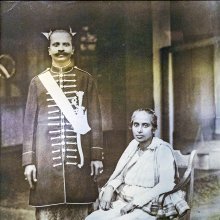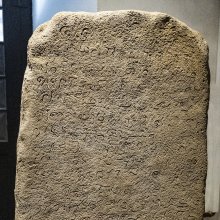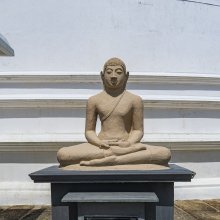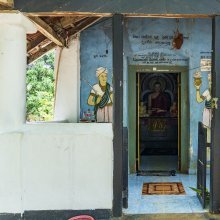Vishi, Vishin, Viṣin, Viśī: 8 definitions
Introduction:
Vishi means something in Hinduism, Sanskrit, Marathi, Jainism, Prakrit. If you want to know the exact meaning, history, etymology or English translation of this term then check out the descriptions on this page. Add your comment or reference to a book if you want to contribute to this summary article.
The Sanskrit terms Viṣin and Viśī can be transliterated into English as Visin or Vishin or Visi or Vishi, using the IAST transliteration scheme (?).
Images (photo gallery)
(+50 more images available)
In Hinduism
Ayurveda (science of life)
Toxicology (Study and Treatment of poison)
Source: Shodhganga: Kasyapa Samhita—Text on Visha ChikitsaViṣī (विषी) refers to “one suffering from the debilitating effects of poison”, according to the Kāśyapa Saṃhitā: an ancient Sanskrit text from the Pāñcarātra tradition dealing with both Tantra and Viṣacikitsā—an important topic from Āyurveda which deals with the study of Toxicology (Viṣavidyā or Sarpavidyā).—Kāśyapa has recommended a slew of generic formulae that successfully neutralise rat poison.—According to Kāśyapasaṃhitā (verse 11.36cd-7ab): “A victim suffering from the debilitating effects of rat-poison (ākhu-viṣī) must be given to drink a solution of seven leaves of tender Vanamālā, found in the weswtern direction, skin of Sahasrāṅghri and Kapittha, mixed with milk”.

Āyurveda (आयुर्वेद, ayurveda) is a branch of Indian science dealing with medicine, herbalism, taxology, anatomy, surgery, alchemy and related topics. Traditional practice of Āyurveda in ancient India dates back to at least the first millenium BC. Literature is commonly written in Sanskrit using various poetic metres.
Languages of India and abroad
Marathi-English dictionary
Source: DDSA: The Molesworth Marathi and English Dictionaryviśī (विशी).—f (vīsa) The age of twenty. Pr. viśīṃ vidyā tiśīṃ dhana or parākrama. 2 An aggregate of twenty more generally.
Source: DDSA: The Aryabhusan school dictionary, Marathi-Englishviśī (विशी).—f The age of twenty; an aggregate of twenty.
Marathi is an Indo-European language having over 70 million native speakers people in (predominantly) Maharashtra India. Marathi, like many other Indo-Aryan languages, evolved from early forms of Prakrit, which itself is a subset of Sanskrit, one of the most ancient languages of the world.
Sanskrit dictionary
Source: Cologne Digital Sanskrit Dictionaries: Cappeller Sanskrit-English DictionaryViṣin (विषिन्).—[adjective] poisoned.
Source: Cologne Digital Sanskrit Dictionaries: Monier-Williams Sanskrit-English DictionaryViśī (विशी):—[=vi-√śī] [Ātmanepada] -śete, to lie outstretched, [Bhāgavata-purāṇa];
—to remain lying or sitting, [Rāmāyaṇa];
—to be subject to doubt, [Śaṃkarācārya]
Source: Cologne Digital Sanskrit Dictionaries: Monier-Williams Sanskrit-English DictionaryViṣin (विषिन्):—[from viṣ] mfn. poisoned, [Pañcarātra]
[Sanskrit to German]
Sanskrit, also spelled संस्कृतम् (saṃskṛtam), is an ancient language of India commonly seen as the grandmother of the Indo-European language family (even English!). Closely allied with Prakrit and Pali, Sanskrit is more exhaustive in both grammar and terms and has the most extensive collection of literature in the world, greatly surpassing its sister-languages Greek and Latin.
Prakrit-English dictionary
Source: DDSA: Paia-sadda-mahannavo; a comprehensive Prakrit Hindi dictionaryVisī (विसी) in the Prakrit language is related to the Sanskrit word: Viṃśati.
Prakrit is an ancient language closely associated with both Pali and Sanskrit. Jain literature is often composed in this language or sub-dialects, such as the Agamas and their commentaries which are written in Ardhamagadhi and Maharashtri Prakrit. The earliest extant texts can be dated to as early as the 4th century BCE although core portions might be older.
See also (Relevant definitions)
Starts with (+20): Vishibavishi, Vishibhu, Vishibhuta, Vishidat, Vishikha, Vishikhantara, Vishikhanupraveshana, Vishikhanupraveshaniya, Vishikhasana, Vishikhashraya, Vishikhashreni, Vishikhavali, Vishikhe, Vishikhin, Vishiksh, Vishikshu, Vishikta, Vishila, Vishim, Vishinj.
Query error!
Full-text (+29): Vici, Vishish, Vishishipra, Vishim, Akhuvishi, Vishibhuta, Viseseti, Vishaya, Vicippalakai, Kutirai-vicikayiru, Vimshati, Vici-tarankaniyayam, Makavici, Vicikaram, Vicippu, Murkhasamajavashi, Vishirshan, Kulavadasamajavashi, Vicuppalakai, Kotiminnal.
Relevant text
Search found 16 books and stories containing Vishi, Vi-shi, Vi-śī, Vi-si, Vishin, Visi, Viśī, Visī, Viṣin, Visin; (plurals include: Vishis, shis, śīs, sis, Vishins, Visis, Viśīs, Visīs, Viṣins, Visins). You can also click to the full overview containing English textual excerpts. Below are direct links for the most relevant articles:
The War Comes < [July – September 1972]
Translation of Oral Literature < [October – December, 2002]
World Journal of Pharmaceutical Research
Phytosomes: Enhancing Bioavailability in Herbal Medicine Delivery < [2020: Volume 9, January issue 1]
Endophytic Fungi: A Promising Source for Natural Therapeutics < [2019: Volume 8, February issue 2]
Antimicrobial and antifungal effects of Tridax procumbens extract. < [2015: Volume 4, October issue 10]
Journal of the European Ayurvedic Society (by Inge Wezler)
Ravigupta’s Siddhasara: New Light from the Sinhala Version < [Volume 1 (1990)]
Astanga Sangraha, Kalpasthana II: Translation and Notes < [Volume 3 (1993)]
A Manual of Khshnoom (by Phiroz Nasarvanji Tavaria)
Appendix VIII < [Appendices]
Influence of Nyaya-Vaisesika on Ayurveda (by Sindhu K. K.)
8. Origin and Development of Vaisesika Darsana < [Chapter 1 - Origin and Development of Nyaya-Vaisesika and Ayurveda]
Notices of Sanskrit Manuscripts (by Rajendralala Mitra)





